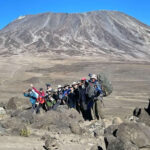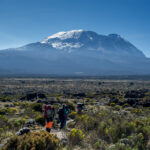
Everyone who’s ever been on a long journey knows it’s not just what you pack, but HOW you pack that counts. But on Kilimanjaro, the limiting factor isn’t the space in your duffle: it’s the weight of your items.
Porters on Kilimanjaro are only allowed to carry 33 pounds each up the mountain, a limit Thomson strictly adheres to for their health and safety. Every trekker with Thomson will have one porter to carry his or her duffle, but if that duffle weighs too much, another will have to be hired on the spot to help out.
It’s easy to avoid the expense of a last-minute personal porter, however. You just have to keep in mind how much weight certain necessary items will add to your total.
TOTAL WEIGHT: 33 pounds
Sleeping Bag: 7-8 pounds, packed

If you own a 0˚ F-rated sleeping bag that you’ve tested in cold conditions, put it to another test: how much does it weigh, packed up?
This is one of the highest-weight items on your list, and one that your porters will have to carry every day (your hiking boots might also add significant weight…but they won’t be packed).
Keep in mind that a 0˚ rating doesn’t mean you’ll sleep comfortably at that outdoor temperature; if you know you get chilly overnight, you may want to bring a higher-rated bag, or add a sleeping bag liner (which may add as much as a pound of additional weight). Pounds remaining: 25-26
Cold-weather jackets and climbing pants: 3-4 pounds

A Kilimanjaro trek generally starts with tropical temperatures (in the 70s and 80s F) and ends with a chilly summit bid around 0˚. Depending on the specific weather conditions when you climb, temperatures might range by more than 100˚ from the warm foothills to the cold summit!
That means you have to pack multiple layers for different types of weather, and when you set out, most of them will be packed in your duffle (read: adding to your weight limit). Your mid-weight jacket, heavier synthetic or down jacket, and warm climbing pants will probably each weigh between 1 and 1.5 pounds. Pounds remaining: 21-23
Outer shell layers/rain protection: 3-4 pounds

You hope you never have to use it, but every trekker absolutely needs to pack a full layer of rain gear, which includes coat, pants, shell mittens, and daypack cover.
We recommend Gore-Tex technology for all of these items which average around a pound apiece (shell gloves and pack cover may weigh less). Pounds Remaining: 17-20
Hat, heavy gloves, mittens, liner gloves, neck gaiter, cold-weather socks: 2-3 pounds

On their own, all these “little thing” cold-weather essentials don’t add up to much. A few ounces here, maybe half a pound there; even when you pack two or three pairs of socks, how much can it really weigh?
But every single item on this list is an absolute essential for your climb, and can’t be left out of your packing considerations. Pounds Remaining: 14-18
Everything else: as much as you let it take up.

We’ve only highlighted a few of the heaviest essentials on your packing list, but already more than half your weight is accounted for. And we haven’t even covered the litany of essential items—sunscreen, personal toiletry items, a camp towel, camp shoes, a headlamp, extra batteries for cameras and devices, etc. etc.—that you likely won’t want to haul around in your day pack throughout your hike.
And remember, your duffle itself will probably weigh a few pounds!
That’s why it’s worth considering how many “extras” you really need (will you use glove-warmers? Are you going to read a book in camp or not?) before you set out to pack.
It’s also why you may want to consider one additional “must-have” item: a travel scale. If you’re packing the right amount of the right items, you should easily stay under the 33 pound weight limit—but it can’t hurt to check (twice).






